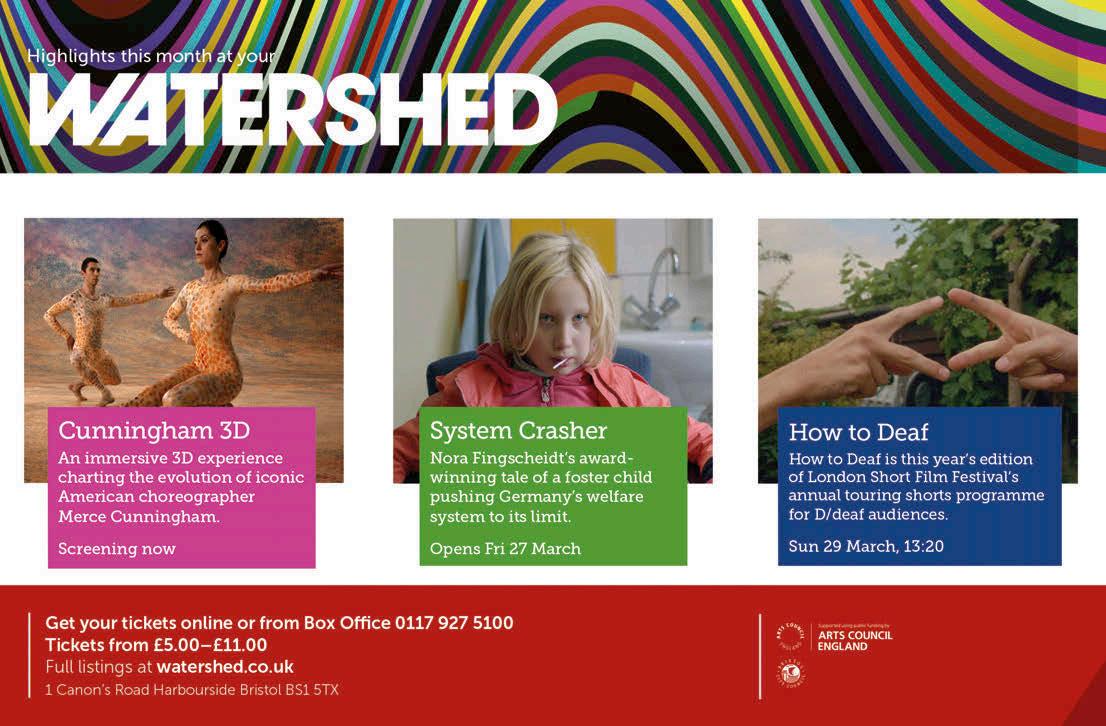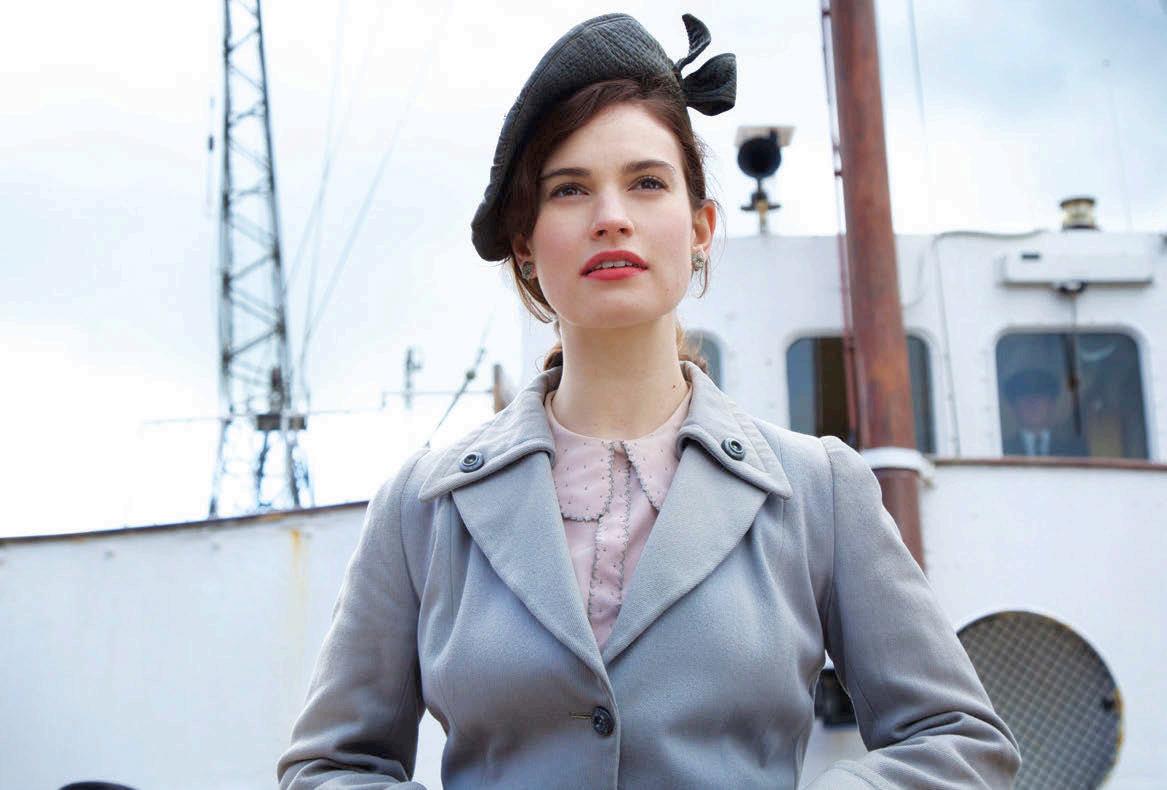
12 minute read
FILM ...followed by a whopping seven pages devoted to the mighty
© ECOSSE FILMS & BBC. PHOTO CREDIT BEN BLACKALL
Mandy’s beehive gets a tweak before her courtroom scene in The Trial of Christine Keeler. “Well, he would say that, wouldn’t he?”
Advertisement
THE WHOLE SHOOTING MATCH Move over Elstree; stand down, Pinewood. National and international TV and film crews are increasingly making a beeline for Bristol, attracted by its creativity and versatility – and right at the centre of this booming local industry is the Bristol Film Office. So, lights, cameras, action: welcome to Bristollywood, baby!
Remember how totally buzzed we all got when the first episode of Skins aired back in 2007? “OMG, it’s Bristol, Nigel! Look; Tony’s crossing actual Vauxhall Bridge! Cassie and Sid are up on Brandon Hill!”
Or our touching excitement, tuning in to Being Human, to discover a vamp, a werewolf and a ghost house-sharing up in Totterdown. Or when a dazed Jodie Comer staggered out from that basement in Thirteen; not a particularly good advert for Lockleaze, but even so.
Of course, we’d always enjoyed glimpses of Bristol on the box. An irate Andrew Lincoln, trying to weave his bike through traffic in Teachers. Trevor Eve, rocking a ’70s ’tache in Shoestring. Only Fools and Horses pretending that Redcliffe was Peckham, and the Young Ones downing pints at the ‘Kebab and Calculator’ at Westbury Park. And that’s even before we get started on Casualty… The occasional film was filmed here, too, the most inherently ‘Bristol’ of them being Clive Donner’s 1962 Some People, with its fascinating views of the mid-century city; and 2006 movie Starter for Ten, co-starring a young James McAvoy, York Crescent, and Bristol Uni. But over the last decade or so (yes, season one of Skins aired in 2007, feel old), Bristol Film Office has taken the whole thing up a serious notch, with back-to-back location shoots for numerous TV dramas ostensibly set elsewhere (we’re looking at you, Sherlock, Wolf Hall, Doctor Who, His Dark Materials, The Trial of Christine Keeler and The Pale Horse) along with a few series that put the city dead-centre (Kiri). Thanks to its versatility, beauty and creativity, Bristol has become the TV producer’s go-to; you can hardly walk through Old City these days without tripping over a dolly rail or bumping into a best boy. WHAT THE FILMMAKERS SAY “To be able to produce a major drama with over 80 speaking parts, with up to 500 people working on it, and to find everything you need in one city that you can get around so easily compared to London, is a remarkable thing. Bristol deserves a BAFTA for the best place to make drama” Executive producer Douglas Rae, The Trial of Christine Keeler
“Bristol is my home city, so I’m biased, but I think it’s the most fascinating city in the country. I’m so proud it’s got this new City of Film status, it’s a place where stories should be told” Jack Thorne, five-time BAFTA-winning screenwriter; Kiri, His Dark Materials
“Bristol is fantastic, vibrant, really colourful, really edgy, completely non-conformist. It was a really good place to film” Sarah Lancashire, actress, Kiri
“I love Bristol. We shot Dirk Gently in Bristol, and it’s a nice mixture of the gritty and the seedy. It’s got a life. Bristol’s past has given it a liveliness which I really enjoy” Stephen Mangan, actor
below: Notting Hill? Nah, St Paul’s, babs opposite: Poldarks’ Cornwall and London, via BS14

52 I BRISTOL LIFE I www.mediaclash.co.uk © ECOSSE FILMS 2019

© BBC & MAMMOTH SCREEN
© BBC & MAMMOTH SCREEN

ON LOCATION The Trial of Christine Keeler used more of Bristol than any single drama for years. Central Library doubled for Marylebone Police Station, offices above St Nicholas’ Market stood in for the War Office and MI5, Wills Memorial Building became the House of Commons and the Lord Mayor’s Mansion House became a Mayfair hotel. St Paul’s doubled for Notting Hill, and many more locations were featured on screen, including Goldney Hall, City Hall, Caledonia Place, Berkley Square, Corn Street, Small Street and Broad Street.
In The Pale Horse, Frogmore Street and Cave Street doubled for the East End, Denmark Street for Soho, properties overlooking St Nicholas Market were brought to life as a period police station, Queen Square doubled as a Chelsea apartment block and Clifton Village’s West Mall doubled as the capital’s King’s Road.
Redcliffe Caves are consistently popular, thanks to their dark and atmospheric look. Most recently they have stood in for the Cornish tin mines in Poldark and as Mars for Doctor Who.
Princes Wharf has accommodated huge crowd scenes for feature films on and around The Balmoral, for example Stan & Ollie and The Guernsey Literary and Potato Peel Pie Society. Meanwhile, up on the big screen, Harbourside has been used for such recent major movies as Stan and Ollie and The Guernsey Literary Potato Peel Pie Society. It’s hard to work out, some days, whether the ss Great Britain has some historical re-enactment thing going on, or whether Hollywood’s come a-calling; either way, we bet Bristol Council’s glad it preserved those M Shed cranes now.
And that’s without taking into account the massive boom in studio work, which knows no geographical bounds; did you know, for example, that Poldark’s Nampara, and many other interior shots, were filmed at The Bottle Yard in Hartcliffe? And while it would have been a bit of a push to use Bristol as stand-in for Svalbard for outdoor shots, the studios had no problem whatsoever creating the roomsets for massive Sky drama series Fortitude. It’s all very exciting, and we’re a bit jealous of Natalie Moore, senior film officer at Bristol Film Office. Natalie’s job includes liaising with the TV and film producers, and making them aware of all the locations, crew and facilities available in Bristol.
“We work with location managers, taking them out on recces and showing them the best sites to fit what they’re looking for,” she says. “Once a production decides to film in Bristol, it’s our job to put permits, security and other arrangements in place, to ensure every shoot goes as smoothly as possible, for both the production and the public.”
Natalie is also project manager for Bristol UNESCO City of Film, working with organisations and individuals to connect and promote the great work coming out of the city in terms of production, talent, festivals, venues, education and skills initiatives; she also works with fellow UNESCO Cities of Film across the world on new and exciting projects.
“Being a UNESCO City of Film means that Bristol is now a member of the UNESCO Creative Cities Network, a worldwide group of over 240 creative cities working together towards a common mission for cultural diversity and sustainable urban development,” says Natalie. “This gives us a unique opportunity to build on our success in film and the moving image, while further embedding those values into how we watch, make and learn about film in Bristol. It also means we can
help Bristol’s film community engage with, and learn from, other cities around the world, by forging international collaborations, creating new artistic exchange programmes and exploring cross cultural projects that might combine film with other mediums within UNESCO’s Creative City fields – for example music, literature and craft.” So, why’s it all happening here? Why in Bristol? “Bristol has so much to offer in terms of locations – everything from caves to green spaces, period architecture, urban streets and more modern developments,” says Natalie.
“The skills and experience of our local crew, facilities and postproduction companies are second to none, and for the last 15 years the Film Office has been consistently providing a ‘film-friendly’ service behind the scenes, giving producers reassurance that they can overcome any problems that might crop up.
“Production teams tell us that they love being able to move around the city more easily than they can in London. We’re on the doorstep of the South West, with period properties, dramatic coastlines, country villages and rugged scenery all a short drive away. And we’re consistently told that the city is popular with visiting cast and crew: they love the sights, the nightlife and restaurants while they are enjoying their downtime.” We’re trying to picture Fortitude’s Dennis Quaid down Mr Wolf ’s, but not entirely succeeding.
Then of course, there’s The Bottle Yard Studios, opened in 2010 and growing rapidly ever since; it’s already hosted over 50 productions, including some of the biggest dramas on screen. More than 20
businesses are now based on site, providing lighting, kit hire, casting and special effects to productions.
“It really has become the heart of Bristol’s production industry,” says Natalie. “The staff are incredibly knowledgeable. Fiona Francombe and her small team are all from production industry backgrounds, meaning they understand the challenges of a production schedule. “The studio space is very flexible, and priced competitively, not too far from London and on the gateway to the South West, so it has developed a reputation as a place where nearly anything is possible. It has a gigantic green screen, the largest outside London, and a huge back lot that can accommodate outdoor street sets, such as the one recently built for Sanditon. “There’s also a real commitment to training the next generation of talent – boomsatsuma runs two diploma courses for 16-19 year olds on site, giving hands-on experience of sets, bringing local benefit, as well as business to the area.”
SOME OF NATALIE’S HIGHLIGHTS “Night shoots at Waring House for the Hellboy movie featuring armoured vehicle, and David Harbour in full superhero costume… the transformation of Blaise Orangery into an ethereal portal to another world for His Dark Materials… the buzz of The Trial of Christine Keeler’s shoot, with all the glamorous 1960s costumes … seeing Frog Lane strewn with apocalyptic dead bodies for Fox’s War of the Worlds… the large Tudor court scenes filming up at Ashton Court for The Spanish Princess… street scenes with horse-drawn carriages for Sherlock…”
clockwise from left: Has that Gabriel Byrne been down Asdol’s and nicked a trolley for War of the Worlds? A young Ray Brooks and David Hemmings in Some People; Rufus Sewell in The Pale Horse

54 I BRISTOL LIFE I www.mediaclash.co.uk IMAGE COURTESY URBAN MYTH FILMS, FOX NETWORKS GROUP, STUDIO CANAL








© BRISTOL FILM OFFICE


No wonder Lily James looks so thoughtful: cranes had to be moved and trains turned around to shoot The Guernsey Literary and Potato Peel PieSociety on Harbourside
And with Channel 4’s arrival in Bristol, says Natalie, the Film Office has started 2020 stronger than ever. “The fact that C4 opted to base one of their regional hubs here is a massive endorsement of the strength of the industry in Bristol, and has further boosted the momentum we were already enjoying after winning the City of Film status a couple of years ago,’ says Natalie.
“It’s really exciting to have their Creative Diversity department based here, which will be working to nurture and develop on- and off-screen talent from all backgrounds. I also hope that having drama commissioners working at the Bristol hub will mean the development of more home-grown drama series for the city. And films don’t come more home-grown than Bait – a back-to-basics, low-budget movie shot entirely on 16mm black-and-white film with a
INSIDE STORIES “We almost had Star Wars filming in a Filton aircraft hangar a few years ago. They cancelled just before they were due to start”
“Some savvy fans of Aidan Turner’s (‘Aidan’s Maidens’) have worked out how to find him when he’s filming in Bristol by following production unit signs that are placed around the city.”
“Kylie once visited The Bottle Yard to see then-fiancé, Joshua Sasse, and filmed cameo scenes for the US TV series, Galavant”
“For Stan & Ollie and The Guernsey Literary Potato Peel Pie Society to film on The Balmoral, cranes had to be moved and locomotives turned around to accommodate both productions. And all during the Easter school holidays…” vintage wind-up Bolex camera, hand-processed in an old Bakelite tank. Since its release last year, it’s been mopping up awards all over the shop. “Bait blasted a strong trail through last year’s international festival circuit and went on to win the Outstanding Debut award at the 2020 BAFTAs, and was nominated in the Outstanding British Film category – it was amazing to see it listed alongside major films like 1917 and Rocketman,” says Natalie.
“Although filmed in Cornwall, Bait was produced by Totterdownbased Early Day Films. Bristol audiences really got behind it during its nine week run at Watershed; it proved so popular that they had to bring it back for an extra week over Christmas and the New Year.”
Obviously, the huge increase in filming means numerous benefits for the local economy, with productions at Bristol locations and/or based at The Bottle Yard Studios bringing in £16 million into Bristol last year alone. “For every ‘broadcast hour’ of on-screen drama made at the Studios, we estimate that around 14 FTE jobs were created. Then you have all the knock-on business brought into the city, by cast and crews booking accommodation, transport, catering and so on.
“Perhaps most importantly, there’s the direct benefit to local crew and the next generation of production professionals living in Bristol; they are able to stay and work here rather than being forced to move to do the job that they love. We also know that seeing a city featured on screen brings film tourism into cities, so we work closely with Destination Bristol to promote walking tours of popular locations to the public, for example with our online Movie Maps and location features.” In the past, we’ve gaily suggested that watching shows and films shot in Bristol made for the ultimate drinking game: down one shot whenever you see Park Street, one for The Downs, and so on. At the pace that Bristollywood’s going, it’s rapidly getting to the point where it’s impossible to do this and drink responsibly… n










